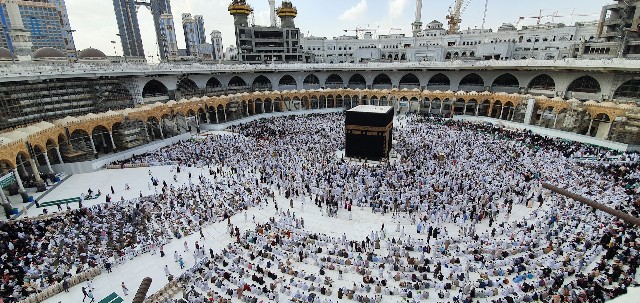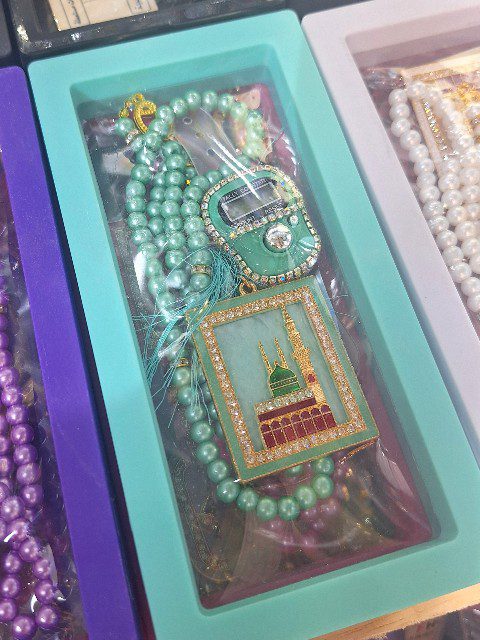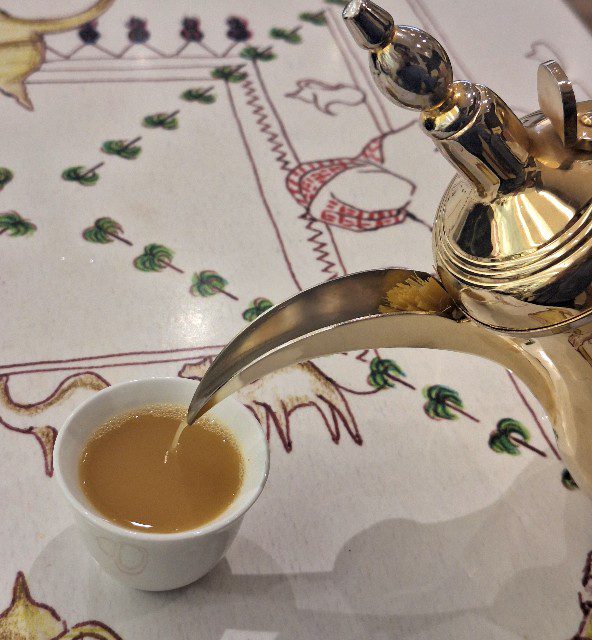In the previous report, I covered up to the departure of the Hegra ruins tour. This time, I’ll report on the experience after finally stepping into the archaeological complex. The ruins enveloped in the soft light of dusk were truly breathtakingly beautiful.
Travel by Bus

View from the bus window. Hegra ruins pass by one after another in front of us. Since there are too many to visit all of them, we focus on 3-4 major ruins for our tour.
Departing from South Gate, the vast desert landscape spreads out through the bus windows. As the guide’s Arabic and English alternated in the vehicle, we learned that this region was once an important hub on the Nabataean Kingdom’s trade routes, while the bus headed toward our first destination.
First Ruins: Jabal Ithlib

A rock that looks somewhat like buttocks – this is the Jabal Ithlib ruins.
When the bus stopped, participants eagerly headed toward the ruins. I appeared to be the only East Asian participant. Once everyone gathered in front of the ruins, the guide began the explanation. Honestly, I hadn’t done sufficient research beforehand, so I was frantically taking notes while listening to the guide’s explanation. (This blog post is also written based on those notes and memories.)

The Jabal Ithlib ruins were an important ritual site located in the center of Hegra. Two enormous rocks lean against each other, and a former assembly hall was established in the space between them. Looking up through the gap between the massive rocks, you feel an overwhelming sense of thrill.

Looking up between the two rocks
Despite the intense July sun, I felt a mysterious coolness as we approached the ruins. The guide explained this was because the structures were designed to cleverly avoid the strong sunlight.
During the ruins tour, there was an interesting interaction. The guide asked participants about the ancient writing carved into the rock walls.
“What do you think this writing on the rock says?”

Looking where the guide points, there indeed appears to be some kind of writing
It certainly looked like writing, but didn’t appear to be Arabic. When someone suggested it might be Hebrew, the guide smiled and shook their head.
“Actually, this is a type of Aramaic. It’s a language that was used in this region before Arabic became widespread.”
Then pointing to another location, they asked again, “What about this writing?”

Regarding what appeared to be Arabic writing alongside a camel drawing, the guide smiled wryly and revealed, “This is probably recent graffiti.” The ironic fact that these 2,000-year-old ruins also bear modern “traces” drew laughter from the participants.
Particularly impressive within the ruins was the space called the “Diwan.” A large room carved directly into the rocky mountain, its shape reminiscent of an ancient dining room or triclinium (Roman-era dining hall). According to the guide’s explanation, this place was used for important gatherings such as royal banquets and political meetings. The open design of the front was probably intended to allow common people to observe from outside.

Spacious assembly hall
To the left of the Diwan is a passage called the “Siq Canal,” through which you can proceed to the center of the mountain. The passage walls retain numerous carvings and inscriptions believed to be related to ancient religious practices.

Guide explaining the carvings and decorations in detail
Particularly fascinating was the water channel system flowing through the center of the mountain. This channel led to natural reservoirs and ultimately directed water to artificial cisterns. In the scorching desert region, how to secure and utilize water must have been a lifeline. I felt this was evidence of the ancient people’s wisdom and advanced technology.
Jabal Al-Banat – The Story of “Mountain of the Daughters”

When the bus arrived at the next location, participants eagerly headed toward the ruins as before. Jabal Al-Banat, meaning “Mountain of the Daughters,” is the largest complex within the Hegra ruins. It’s a historically valuable site with 29 tombs either built by women or created for women.

Large ruins with over 20 “entrance”-like structures lined up
Among the many tombs, only some can be entered. However, among the excited participants, some tried to enter restricted areas. The guide frequently called for caution. It was a glimpse into the difficulties of ruins protection and safety management.

Definitely enter the ruins where access is permitted
The interior of the tomb we were permitted to enter was an impressively powerful space that couldn’t be imagined from the outside. The ceiling height was easily 5 meters or more, like a two-story house with an atrium.

The interior is quite spacious
According to the guide’s explanation, the window placement embodies the engineering wisdom of that time. In the scorching land of Hegra, it was carefully calculated to efficiently deliver cool air to the interior. While the interior was indeed cooler than the outside temperature, as more than 20 participants gathered in one tomb to listen to the guide, we gradually began to feel the stuffiness.

The archaeological value of Jabal Al-Banat is extremely high, with textiles and leather goods discovered along with human bones at this site. These artifacts serve as valuable clues for understanding the lifestyle of the ancient Nabataeans.
According to the guide’s explanation, some women in this region possessed considerable wealth. For example, at nearby Jabal Ahmar (Red Mountain), the tomb of a woman named Hinat was discovered. She was wealthy enough to build tombs for herself and 80 descendants. This suggests that in Nabataean society, women could also possess considerable economic power and social status.

On our way back to the bus after the tour, a family in a jeep raced past us. Despite being a support jeep, seeing them race stylishly through the desert made me want to ride one too. However, walking wasn’t bad either. Stepping on the fine sand while walking, with movie-like rocky mountains spreading around us and ruins evoking romance with ancient times in front of us – this scenery had its own distinct flavor.

Tour participants returning to the bus. Visible ahead is the highlight ruins we’ll visit next: Tomb of Lihyan Son of Kuza.
How Was It?
Next time, I plan to report on visiting the remaining ruins, including the “Tomb of Lihyan Son of Kuza,” which could be called the highlight of Hegra ruins. Stay tuned!






Pingback: Exploring Madain Saleh in AlUla (Part 3) – The Tomb of Lihyan, Son of Kuza: Hegra’s Grand Finale - Kosupa Travel